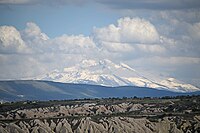
Photo from wikipedia
Abstract The Erciyes stratovolcano in central Turkey has several young rhyodacite lava domes that show evidence of clear exposure histories but have hitherto unknown ages. We collected 27 surface samples… Click to show full abstract
Abstract The Erciyes stratovolcano in central Turkey has several young rhyodacite lava domes that show evidence of clear exposure histories but have hitherto unknown ages. We collected 27 surface samples from three volcanic domes namely Karagullu, Perikartin and Dikkartin for cosmogenic 36Cl dating. The Perikartin eruption generated a pyroclastic flow, which buried trees that were converted to charcoal. The radiocarbon (14C) dating yielded an average age of 9728 ± 110 cal. years B.P. (calibrated using Calib 7.1). We analyzed the cosmogenic 36Cl ages, however, were found that they were probably affected by Cl degassing of the magma. Our study suggests that the radiocarbon age indeed lies between the 0% Cl degassing (6.8 ± 0.5 ka, under nucleogenic 36Cl equilibrium) and the 100% degassing conditions (9.9 ± 0.6 ka, under nucleogenic 36Cl disequilibrium), which implies a partial Cl degassing (93%) during the eruption. This value is somewhat higher than earlier estimates and the difference may result from the miscalculated nucleogenic and/or low-energy neutron production of 36Cl, uncertainties arising from the corrections due to hydrogen-rich cover (i.e., snow) of lava surfaces or due to unconsidered geological complications. Our findings provide a novel approach to estimate the Cl degassing on young lavas and deliver a new evidence of the Holocene volcano-chronology of the central Anatolia.
Journal Title: Journal of Volcanology and Geothermal Research
Year Published: 2019
Link to full text (if available)
Share on Social Media: Sign Up to like & get
recommendations!